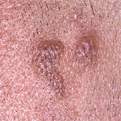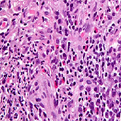Granuloma Faciale
General Information
Granuloma Faciale is a rare, non-cancerous skin disorder occurring on the face. Papules, plaques and nodules characterize the disorder. Granulomas refer to a kind of inflammation found on microscopic examined lesions, but granulomas are not seen in granuloma faciale. These lesions vary in color (reddish-brown, blue or purple) and size (millimeters to several centimeters). Granuloma faciale is an asymptomatic disorder, some patients may complain of the lesions feeling tender, itching or stinging. Lesions appear more often on sun-exposed areas and darken when exposed. Treatments include Corticosteroid injections; Dapsone; Antimalarial tablets (hydroxychloroquine); Topical psoralen UV-A (PUVA); Radiation therapy; surgical therapy may also be used, but can leave some scarring.
Epidemiology
Rare
Etiology
Some cases are idiopathic. A gamma interferon–mediated process has been suggested.
Pathogenesis
Round, sharply demarcated, mildly infiltrated and grow to a few or several centimeters in size
Clinical
Solitary or, more commonly, multiple, soft, elevated, and well-circumscribed papules, plaques, or nodules are observed
Histology
Dense polymorphous infiltrate located mainly in upper dermis and a ‘grenz zone’ of normal collagen separates it from the epidermis and pilosebaceous appendages. The infiltrate consists of neutrophils and eosinophils often lymphocytes, histiocytes, plasma cells and mast cells.
Bibliography
1. “Granuloma Faciale” (Online). http://www.emedicine.com/derm/topic170.htm (visited: March 18, 2008)
Download PDF
![]() Granuloma Faciale
Granuloma Faciale


